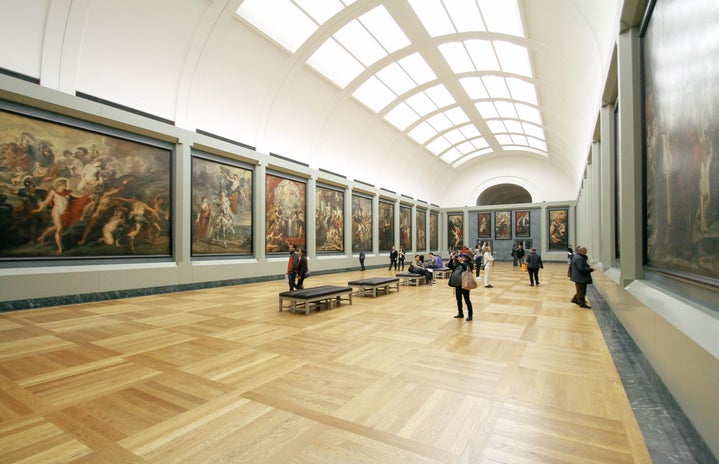Trigger Warning: Topics within this article contain sexual assault.
I am taking Art History: Renaissance to Modern Art here at Kent State this semester. It was through this class and Dr. Shana Klein (Reisig) that I got to learn about an amazing woman: Artemisia Gentileschi (aar·tuh·mee·zhuh jen·tuh·leh·skee). Dr. Reisig’s lecture on Women as Artists and Muses was so inspiring, while also filling me with a bit of feminine rage for the women who went through the toughest battles and paved the way for women today.
I feel Artemisia is the perfect woman to highlight for Women’s History Month, as she is often considered the first feminist artist. Artemisia was born July 8, 1593 in Rome, Italy. She is now commonly known by her first name Artemisia, like superstar male artists such as Michelangelo or Caravaggio. So, to begin to put some respect on her first name that is how I will be referring to her.
Artemisia lived in a period when female painters were not often accepted or allowed into painting or design academies. Despite this fact, she was the first woman to become a member of the Accademia Di Arte Del Disegno (Academy of Fine Arts) in Florence. Artemisia was first taught by her father, Orazio Gentileschi, who was an artist himself. Artemisia overcame so much adversity as a woman in the Baroque Era. At this time, women were not allowed to do many things that were needed to excel in painting.
Women could not be part of Gilds, they had no long term patrons and they could not travel alone if they were part of a higher class. Even in their own homes, women could not enter the library. Women at this time had very low mobility in general. They could not study the human figure as men did either. Men were known to study cadavers at the morgue, which was not an option for women. In a plainer sense, women were at an extreme disadvantage.
At this time, women were not even on a mission to become the best artists or to have super innovative ideas–they simply want to be accepted. Into schools and as equals. It’s a war women are still battling today. I want to highlight a few of my favorite paintings from Artemisia, the ones I feel provide a powerful message for all women. The first is called “Judith Slaying Holofernes.”
Something to keep in mind when it comes to Artemisia is that she is not only a woman in a man’s career, but she is a woman painting manly content. A quick background on the story depicted in this painting: Judith saves her people by killing the enemy, slicing off his head with his own sword, which is the scene depicted in this painting. Judith is portrayed with similar features to Artemisia herself.
Artemisia represents this scene with such emotion and powerful feminine energy. Judith looks incredibly sure of herself and her actions. Artemisia’s depiction has action and movement to it. You can see Holofernes’ struggle and the strength Judith and her maid are putting forth to hold him down. This painting is so naturalistic: the way the people are painted, the lighting and the blood dripping down the sheets. All despite Artemisia not being able to study the human body for accuracy the way male artists were.
The next painting I want to highlight has some hard topics involved. But, I cannot talk about Artemisia without telling you about the sexual assault she endured. At 17 years old, Artemisia was raped by her painting tutor, Agostino Tassi. Artemisia paints “Susanna and the Elders” not too long before, possibly around the time of her assault. It is said to be one of her first known works. “Susanna and the Elders” is a painting that draws inspiration from the fictitious Old Testament tale of Susanna. The artwork depicts a nude young woman sitting by a bathtub. Two much older, fully clothed, wailing men loom aggressively over her. They put their fingers to their lips in an attempt to silence her. Susanna courageously refuses their demands for sex-related favors. Artemsisia depicts the moment before Susanna is raped by these men.
Even though Susanna and the Elders’ story has been painted numerous times, Artemisia’s painting is special because it was the first to be painted by a woman, making it a first for revolution as well. Artemisia takes her rapist to court where she endured the pain of a thumbscrew, a torture device used in early modern Europe.
It was a simple device occasionally featuring interior surfaces with projecting studs. Sometimes the crushing bars had metal points that were sharp enough to pierce nails. This device was used on Artemisia to test the veracity of her statement. It was believed that if she could not endure the pain of this torture, she was not being truthful about her accusation. Artemisia endures. An artist enduring the pain of her hands being crushed–a body part she needs in order to paint–was huge.
Her trial received a considerable amount of publicity at the time. As for the verdict, it is not unequivocally known. The most reported is that Tassi was convicted, but later released by the judge.
Artemisia continued to paint popular biblical and mythological heroines throughout her career. But, the last painting I want to highlight here is another one of Artemisia’s self portraits.
Artemisia paints this portrait of herself as Saint Catherine of Alexandria around 1616, about four years after her trial. The above portrait is now one of the very few paintings by women in The National Gallery in London. Within a collection of over 2,300 paintings, which date from the 13th to the early 20th century, why are there only 21 paintings created by women?
Artemisia’s “Self Portrait as Saint Catherine of Alexandria” was purchased by the gallery in 2018 for £3.6 million. Now what is so moving about this piece by Artemisia that I have decided to save it for last? Well, Artemisia portrays herself in three-quarter view holding a broken spiked wheel, which is said to have been the torture device used on Saint Catherine of Alexandria prior to her beheading. She is also holding a palm frond in her other hand, which serves as a traditional symbol of martyrdom.
Current research on the contemporaneous works of Artemisia suggests the painting was originally intended to be a total self-portrait before being altered to include Saint Catherine. If this is proven to be true, Artemisia’s decision to make the addition is so incredibly moving. A women who was tortured on trial herself, painting herself as a female Saint who was also tortured on trial? The palm leaf to symbolize martyrdom? Both objects are so poetic and significant in their depiction and symbolism within the portrait. Many people disliked Artemisia after her trial, but she didn’t let that deter her from standing her ground during her trial or continuing to produce her art.
Artemisia and her courageous historical paintings challenged the way men had traditionally portrayed women. She presented complex, brave, intelligent and strong female characters in their place. In 1649 she wrote to her patron “I will show your illustrious Lordship what a woman can do.” Her art served as her battleground, and the triumph she achieved through it has benefited all women. The idea that women could change the world to suit their needs and achieve success was made achievable by Artemisia, and I thank her.
Information in this article from:
https://artsandculture.google.com/story/hwWBb49O1FXZqg
If you enjoyed this article, check this out: https://www.artnews.com/art-news/retrospective/why-have-there-been-no-great-women-artists-4201/


